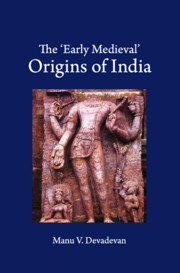Book contents
- Frontmatter
- Dedication
- Contents
- List of Tables
- List of Maps and Figures
- Acknowledgements
- 1 Introduction
- I INSTITUTIONS
- 2 State Formation and Its Structural Foundations
- 3 From the Cult of Chivalry to the Cult of Personality: The Seventh- Century Transformation in Pallava Statecraft
- 4 Changes in Land Relations and the Changing Fortunes of the Cēra State
- 5 Temple and Territory in the Puri Jagannātha Imaginaire
- II IDEAS
- 6 Svayaṃbuddha's Predilections: The Epistemologies of Time and Knowledge
- 7 Bhāravi and the Creation of a Literary Paradigm
- 8 Knowing and Being: The Semantic Universe of the Kūḍiyāṭṭaṃ Theatre
- 9 The Invention of Zero and Its Intellectual Legacy
- III IDENTITIES
- 10 The Evolution of Vernacular Languages: A Case Study of Kannada
- 11 Religious Identities in Times of Indumauḷi's Grief
- 12 Caste, Gender, and the Landed Patriarchy
- 13 The Making of Territorial Self Consciousness (with Particular Reference to Kaliṅga)
- Bibliography
- Index
13 - The Making of Territorial Self Consciousness (with Particular Reference to Kaliṅga)
Published online by Cambridge University Press: 02 May 2020
- Frontmatter
- Dedication
- Contents
- List of Tables
- List of Maps and Figures
- Acknowledgements
- 1 Introduction
- I INSTITUTIONS
- 2 State Formation and Its Structural Foundations
- 3 From the Cult of Chivalry to the Cult of Personality: The Seventh- Century Transformation in Pallava Statecraft
- 4 Changes in Land Relations and the Changing Fortunes of the Cēra State
- 5 Temple and Territory in the Puri Jagannātha Imaginaire
- II IDEAS
- 6 Svayaṃbuddha's Predilections: The Epistemologies of Time and Knowledge
- 7 Bhāravi and the Creation of a Literary Paradigm
- 8 Knowing and Being: The Semantic Universe of the Kūḍiyāṭṭaṃ Theatre
- 9 The Invention of Zero and Its Intellectual Legacy
- III IDENTITIES
- 10 The Evolution of Vernacular Languages: A Case Study of Kannada
- 11 Religious Identities in Times of Indumauḷi's Grief
- 12 Caste, Gender, and the Landed Patriarchy
- 13 The Making of Territorial Self Consciousness (with Particular Reference to Kaliṅga)
- Bibliography
- Index
Summary
The chapters in this book were put together with a specific purpose in mind: to present the thesis that institutions, ideas, and identities typically associated with India and recognized as Indian in popular imagination as well as learned discourses had their origins in the period that contemporary historiography designates as the ‘early medieval’. We have seen that some of them, such as the state, gender relations, and kāvya literature, had their roots in earlier historical processes going back to the first millennium BCE but were reconstituted in a thoroughgoing manner in structural, functional, and ideational terms between the seventh and the twelfth centuries CE. What evolved by the end of the twelfth century have by no means been preserved and continued in that form in later times. Our assessment of the Jagannātha temple of Puri and the Kūḍiyāṭṭaṃ theatre of Kerala, and the catalogic survey of developments in mathematics and astronomy between the thirteenth and the nineteenth centuries bear out the scale and substance of changes in later times.
Territory occupies a central place in contemporary imaginations of India. The impassioned visions of sovereignty, security, and territorial integrity that the territory produces in the garb of the nation are powerful enough to sideline every other concern, be it language, caste, or gender relations. In their avowedly secular versions, they do not fail to suspend religion either, although there are influential and diabolic schools of nationalism that swear by a homology between territory and religion. We must, therefore, conclude this book by exploring the making of territorial self-consciousness in India. In doing so, we will lay special emphasis on the region of Kaliṅga as a case study.
When the Magadhan state began to expand across northern India in the fifth and fourth centuries BCE, Kaliṅga on the east coast was still the name of a lineage group and, by extension, the country inhabited by that group. The state of affairs on the eve of Aśōka's invasion of the region in the mid third century BCE was not different enough to a degree that merits serious reflection. However, towards the close of the first millennium BCE, the first signs of a transition towards a new geopolitical order were beginning to be felt.
- Type
- Chapter
- Information
- The ‘Early Medieval' Origins of India , pp. 387 - 442Publisher: Cambridge University PressPrint publication year: 2020



